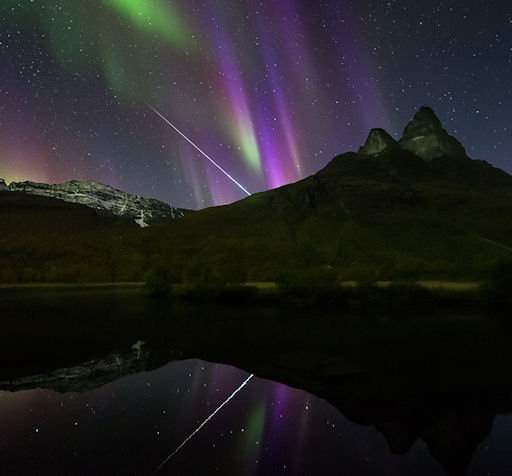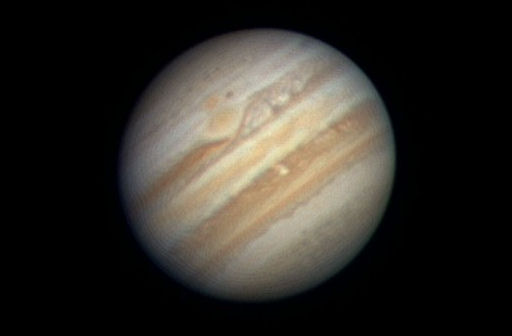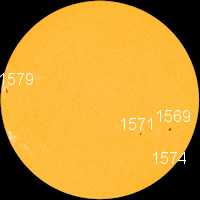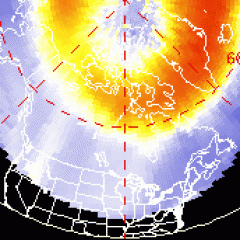CMEs MISS EARTH: The Solar and Heliospheric Observatory (SOHO) has observed at least three CMEs billowing away from the sun during the last 24 hours. However, none of the clouds are heading for Earth. The source of the explosions appears to be on the far side of the sun. Aurora alerts: text, voice.
AUTUMN LIGHTS: Northern autumn is only two days away--and that means it's aurora season. For reasons researchers don't fully understand, the days around equinoxes are the best times to see Northern Lights. Indeed, the Arctic Circle is glowing. Last night, Ole C. Salomonsen photographed the ongoing display from Tromsø, Norway:
"The sky was full of awesome auroras in magnifcent shapes and colors," says Salomonsen. "I also saw a magnificent blue fireball streaking through the lights above my favorite mountain Otertinden. It was the biggest fireball I have ever caught on camera. What a great photographic moment for me!"
More scenes like this are in the offing. NOAA forecasters estimate a 25% to 30% chance of strong polar geomagnetic storms for the next three nights as a series of solar wind streams gently buffet Earth's magnetic field. Aurora alerts: text, voice.
DISAPPEARING ASTEROID: More than a week after amateur astronomers witnessed an explosion in the cloudtops of Jupiter more powerful than an atomic bomb, no debris has appeared at the blast site. "I took a picture of Jupiter on Sept. 15th using the same telescope that I used to observe the brilliant fireball flash above Jupiter's clouds on the morning of Sept. 10th," reports Dan Petersen of Racine, Wisconsin, the man who saw the explosion first. "This photo shows that five days after the explosion there was still no signature debris cloud near 'ground zero.'"
The absense of debris suggests that the source of the explosion, probably an asteroid, was small. Studies show that Jupiter is a frequent target for 10-meter class space rock, and this is almost certainly another example of Jupiter getting hit. The giant planet absorbed the explosion and swallowed the remains of the asteroid whole.

![]()
Solar wind
speed: 575.8 km/sec
density: 1.0 protons/cm3
explanation | more data
Updated: Today at 1557 UT
![]()
X-ray Solar Flares
6-hr max: C1 1140 UT Sep20
24-hr: C1 1140 UT Sep20
explanation | more data
Updated: Today at: 1459 UT
![]()
![]()
![]()
Daily Sun: 19 Sep 12
![]()
![]()
Solar activity is low despite the emergence of big new sunspot AR1579. Credit: SDO/HMI
![]()
![]()
![]()
Sunspot number: 62
What is the sunspot number?
Updated 19 Sep 2012
Spotless Days
Current Stretch: 0 days
2012 total: 0 days (0%)
2011 total: 2 days (<1%)
2010 total: 51 days (14%)
2009 total: 260 days (71%)
Since 2004: 821 days
Typical Solar Min: 486 days
Update 19 Sep 2012
The Radio Sun
10.7 cm flux: 104 sfu
explanation | more data
Updated 19 Sep 2012
![]()
![]()
![]()
Current Auroral Oval:
![]()
Switch to: Europe, USA, New Zealand, Antarctica
Credit: NOAA/POES
![]()
![]()
![]()
Planetary K-index
Now: Kp= 2 quiet
24-hr max: Kp= 4 unsettled
explanation | more data
![]()
Interplanetary Mag. Field
Btotal: 3.2 nT
Bz: 0.4 nT south
explanation | more data
Updated: Today at 1557 UT
![]()
![]()
![]()
Coronal Holes: 19 Sep 12
![]()
![]()
A solar wind stream flowing from the indicated coronal hole should reach Earth on Sept 22-23. Credit: SDO/AIA.






